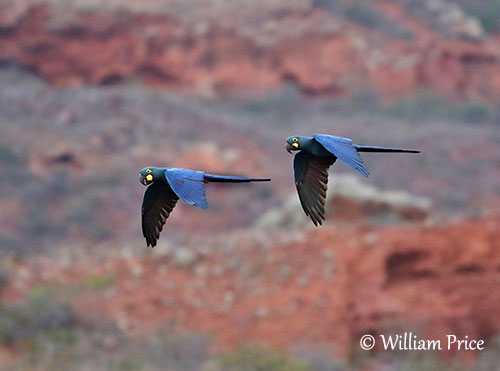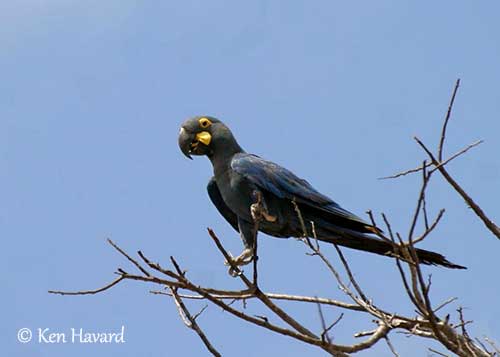
Fr: Ara de Lear
Ang: Lear’s Macaw - Indigo Macaw
All: Learara
Esp: Guacamayo de Lear
Ita: Ara indaco
Nd: Lears Ara
Sd: indigoara
Photographers:
Ken Havard
My Bird Gallery & Flickr gallery 1 & Flickr gallery 2
William Price
PBase-tereksandpiper & Flickr William Price
Text by Nicole Bouglouan
Related articles :
Parrots and clay… an old story!
Loro Parque Foundation and Parrots
Sources:
PARROTS OF THE WORLD – An Identification Guide – by Joseph M. Forshaw – Princeton University Press – ISBN 0691092516
HANDBOOK OF THE BIRDS OF THE WORLD vol 4 by Josep del Hoyo-Andrew Elliott-Jordi Sargatal - Lynx Edicions - ISBN: 8487334229
Wikipedia, the free encyclopaedia
ACTP - LEAR'S MACAW - BLUE PARROT UNDER PRESSURE
Lear’s Macaw or Indigo Macaw
Anodorhynchus leari
Psittaciformes Order – Psittacidae Family
INTRODUCTION:
The Lear’s Macaw or Indigo Macaw is endemic to Brazil where it has very restricted range in NE. This rare species was discovered in 1978, and its name pays tribute to the English bird painter and artist Edward Lear (1818-1888). This macaw was first described in 1856 by Charles Lucien Bonaparte, but it was considered a distinct species only in 1978, when a wild population was localized by the ornithologist Helmut Sick.
The Lear’s Macaw resembles the Hyacinth Macaw but it is smaller and has slightly paler plumage. The species is classified as Endangered after historical decline due to trapping, but today, the population is fairly stable, thanks to intensive conservation measures.

DESCRIPTION OF THE BIRD:
Biometrics:
Length: 75 cm
Weight: 950 gr
The Lear’s Macaw has metallic blue plumage. Head and neck are slightly washed greenish. The upperwing is brighter blue, including the flight-feathers. The long, graduated tail is blue.
On the underparts, the breast shows some rufous wash. Flight-feathers and undertail are dark grey.
On the head, we can see a semi-circular pale yellow patch of bare skin at base of lower mandible.
The hooked bill is grey-black. The eyes are dark brown, surrounded by yellow, bare eyering. Legs and feet are dark grey.
Male and female are similar.
The juvenile resembles adults, but the bare skin of the head is paler yellow and the tail is shorter.
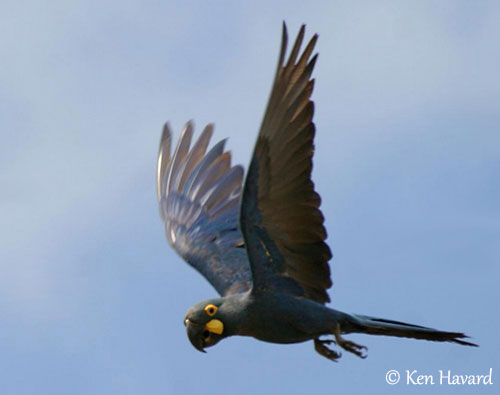
RANGE:
The Lear’s Macaw is found in NE Brazil where it occurs in a small area in NE Bahia. Two colonies are known, in Toca Valha and Serra Blanca, S of the Raso da Catarina plateau.
HABITAT:
The Lear’s Macaw inhabits arid caatinga woodland with mainly thorny bushes and clumps of Syagrus palms which are the main food trees.
It breeds and nests in sandstone cliff-faces, outcrops and rugged gorges, also used as roost sites.
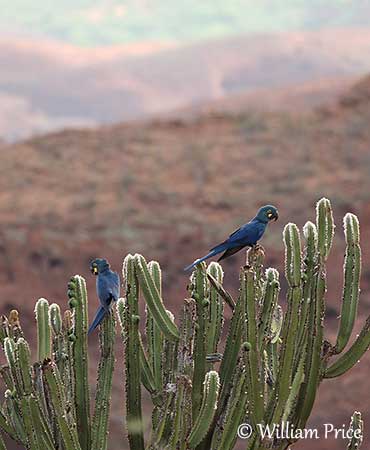
CALLS AND SONGS: SOUNDS BY XENO-CANTO
The Lear’s Macaw gives croaking and screeching calls “gree-ah” and “ara-ara…trrahra” but less raucous and weaker than Hyacinth Macaw.
BEHAVIOUR IN THE WILD:
The Lear’s Macaw feeds primarily on nuts of licurí palms (Syagrus coronata), but it also takes fruits from other plant species, Agave flowers, seeds of Melanoxylon, and occasionally maize crops.
They feed in groups of 3-4 birds in palm trees, about 5-30 metres apart. Some off them act as “sentinels” while the flock is feeding, and the birds regularly alternate the roles.
The Lear’s Macaw is a gregarious species; they gather at communal roosting sites in cliff-faces. They rest in burrows in small groups of 3-4 birds. Some individuals may roost on ledges or cling to the cliff-face.
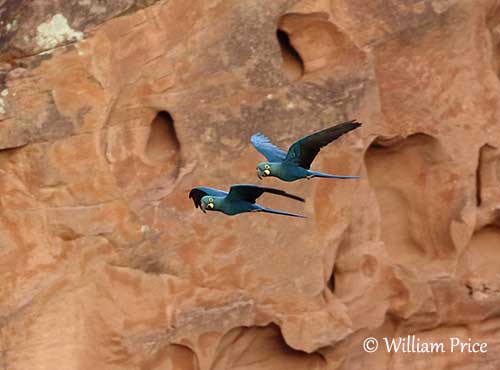
They leave the roosts before dawn and disperse in small groups to reach their feeding areas. They return to the cliffs just after sunset. They fly while calling loudly, but they perch first in nearby trees and move to the roosting sites only in the darkness.
The Lear’s Macaw is resident and remains year-round near the cliffs.
The flight is steady with strong, deliberate wingbeats.
REPRODUCTION OF THIS SPECIES:
The breeding season occurs between December and May, with peak in February/April.
The Lear’s Macaw nests in fissure or crevice in sandstone cliffs. The birds soften the sandstone with saliva before to excavate a small crevice with the bill, while they scrape the dust with the feet. The pair probably defends the nest-site.
The female lays two eggs. The incubation in captivity lasts at least 28 days. The juveniles are sexually mature at about 2-4 years of age.
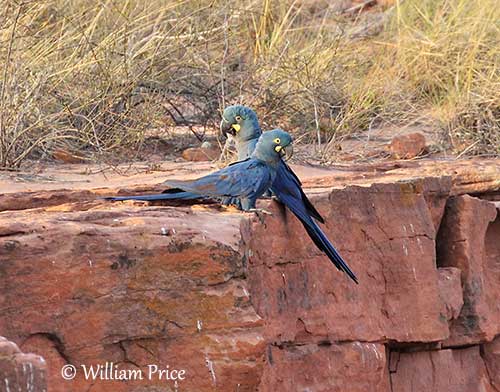
PROTECTION / THREATS / STATUS:
The Lear’s Macaw is heavily threatened by habitat loss, especially the loss of the feeding palm trees now reduced by livestock-grazing. This species is vulnerable to trapping, although this threat has been reduced, but it currently continues.
These birds are sometimes persecuted when they forage on maize crops, and they may suffer hunting pressure too.
The Lear’s Macaw is a restricted-range species with only two main colonies, but some new smaller populations have been discovered.
The population is estimated to number 1,263 individuals, with a large proportion of sub adults. Mature individuals are roughly estimated at 228. The global population of this species is placed in the band 250/999 mature individuals.
The Lear’s Macaw has today increasing numbers due to intensive conservation measures, but it is currently listed as Endangered.
